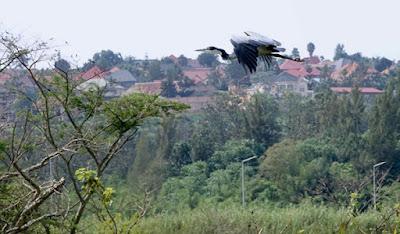
Black-headed Heron, Nyandungu Urban Wetlands Eco-Tourism Park, Kigala, Rwanda
My friend Karen Minkowski, a frequent contributor to The Intrepid Tourist and definitely an intrepid traveler, is currently in Africa, a place that she has visited often. Karen is a keen birdwatcher and I thank her for sharing her wonderful photos of the birds of Nyandungu with The Intrepid Tourist.
While visiting Kigali, Rwanda’s capital city, in early 2023, I took my camera to NyandunguUrban Wetlands Eco-Tourism Park, in one of Kigali’s many valleys. The Park comprises 120 hectares (297 acres) of a restored wetland complex -grasslands, ponds and a small fig forest. It was created to reestablish some of Kigali’s lost biodiversity and to provide the community with social and economic benefits (lots of jobs!). Somewhere between one and two hundred species of birds reside in or use the Park’s habitats. The Park is buffered from the surrounding suburbs by agricultural fields. In the photo above a Black-headed Heron flies across the grassy wetland.
I’ve recently returned to Rwanda for a longer stay, and I visit Nyandungu frequently. My photos are annotated with a few facts I gleaned from Google and Google Scholar. Cornell University’s online Birds of the World is a favorite source. Here are some of the birds I’ve seen:
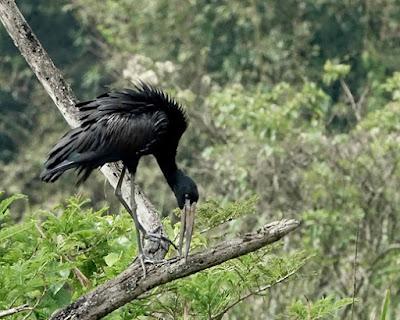
African Openbill
The African Openbill is a stork that feeds primarily on mollusks. Within seconds, it can pry open and extract a snail from its shell, using the tip of its lower mandible. It cuts the muscle that keeps the shell closed, rather than crunching it. Greater effort is needed to open mussel shells, so Openbills may deposit captured mussels on the shore, leaving the sun to kill them. As the mussels die, they release their hold on their shells. In this photo the Openbill is likely probing for insects in the dead wood.
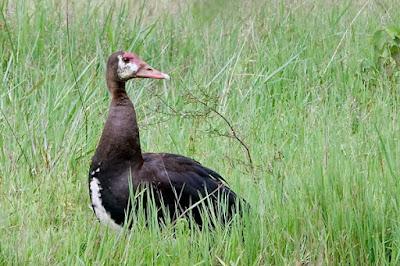
Spur-winged Goose
The Spur-winged Goose derives its name from a small spur, or spike, at the bending point of each wing and is used in fighting during the breeding season. Spur-winged geese that eat the poisonous Blister Beetle store the toxin in their tissues, which may kill whatever subsequently eats the geese.

African Stonechat
The African Stonechat is an Old-World flycatcher that feeds almost exclusively on insects, their larvae, and other invertebrates. It occupies a wide range of habitats on the continent.

Common Bulbul
A very common bird throughout much of Africa south of the Sahel, the Common Bulbul is primarily a fruit-eater, but also takes a few insects and small vertebrates.
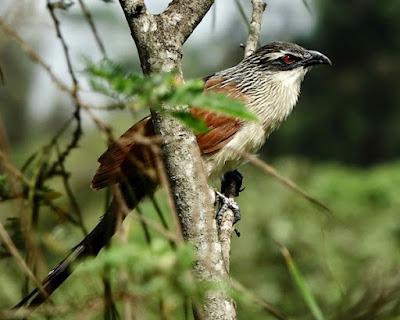
White-browed Coucal
The elegant White-browed Coucal has a lovely call, a kind of soft, warbling sound. Its body pulses to the rhythm of the call, a bit like bellows. Male White-browed Coucals spend more time than females incubating the eggs, but both sexes share the task of feeding their young. They eat mostly insects, spiders, and small invertebrates.
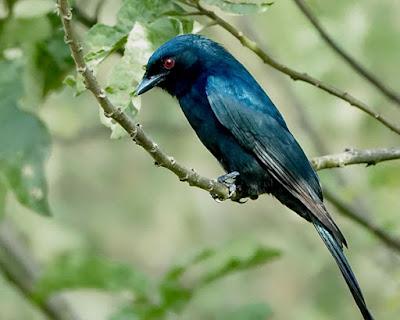
Fork-tailed Drongo
Fork-tailed Drongos are known to give false alarm calls to scare other bird species into abandoning their food to a thieving drongo. They also mimic the alarm calls of other species for the same purpose. Why hunt when there are easier ways to get a good meal?
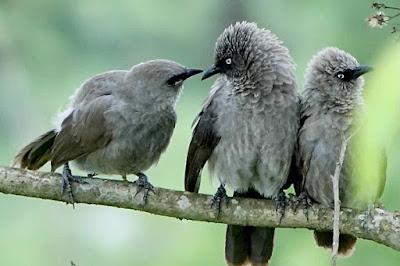
Black-lored Babblers
Black-lored Babblers are highly sociable birds. The one on the left had been grooming the bird in in the middle, then moved a short distance away and returned a few seconds later. It is tempting – if hopeless - to imagine what they are communicating with these postures and expressions! These birds literally babble when grouped together, as if they cannot contain their excitement. The authors of a bird guide describe the sound as having a “slightly insane and hilarious laughing quality”.
